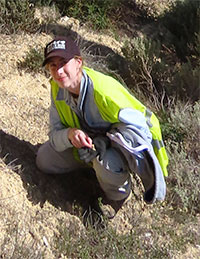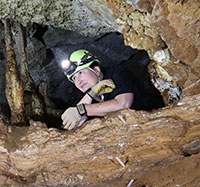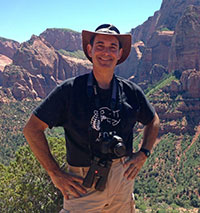 Mahala A. Fergusen. School of Biological Sciences, Faculty of Sciences, Engineering and Technology, University of Adelaide, North Terrace, Adelaide, South Australia 5005, Australia. mahala.fergusen@adelaide.edu.au
Mahala A. Fergusen. School of Biological Sciences, Faculty of Sciences, Engineering and Technology, University of Adelaide, North Terrace, Adelaide, South Australia 5005, Australia. mahala.fergusen@adelaide.edu.au
https://orcid.org/0000-0002-9190-8289
Mahala is a PhD candidate at the University of Adelaide, studying the Miocene invertebrate fauna of the southern Australian region. She is examining the systematics, palaeobiology, and UV fluorescence of the taxa. Her main sites of study are the Naracoorte region and the Murray River, South Australia.
![]()
 Elizabeth H. Reed. School of Biological Sciences, Faculty of Sciences, Engineering and Technology, University of Adelaide, North Terrace, Adelaide, South Australia 5005, Australia. liz.reed@adelaide.edu.au
Elizabeth H. Reed. School of Biological Sciences, Faculty of Sciences, Engineering and Technology, University of Adelaide, North Terrace, Adelaide, South Australia 5005, Australia. liz.reed@adelaide.edu.au
https://orcid.org/0000-0001-6103-1861
Liz Reed uses evidence from fossil deposits in caves to reconstruct past biodiversity. Caves accumulate a wealth of materials that tell us about past environments, including a rich fossil record of vertebrate faunas. By studying how animal and plant communities responded to changes in climate and environment in the past, Liz can assess how current and future change will impact the conservation of Australia's threatened species and habitats. Much of her research centres on the World Heritage Naracoorte Caves and the Nullarbor Plain.
![]()
 Diego C. García-Bellido. School of Biological Sciences, Faculty of Sciences, Engineering and Technology, University of Adelaide, North Terrace, Adelaide, South Australia 5005, Australia and Earth Sciences Section, South Australian Museum, North Terrace, Adelaide, South Australia 5000, Australia. diego.garcia-bellido@adelaide.edu.au
Diego C. García-Bellido. School of Biological Sciences, Faculty of Sciences, Engineering and Technology, University of Adelaide, North Terrace, Adelaide, South Australia 5005, Australia and Earth Sciences Section, South Australian Museum, North Terrace, Adelaide, South Australia 5000, Australia. diego.garcia-bellido@adelaide.edu.au
https://orcid.org/0000-0003-1922-9836
Diego studies the early evolution of complex life during the Ediacaran and Cambrian, half a billion years ago. He excavated at the famous Burgess Shale Cambrian fossil locality in Canada between 1995 and 2000 and worked at the Royal Ontario Museum in Toronto for several years. In 2007 he joined the Australian research team excavating the Cambrian Emu Bay Shale in Kangaroo Island and for the last decade he has also been studying the Ediacara Biota from the Flinders Ranges, with the goal of finding the links of these iconic organisms with the Cambrian faunas. Diego has carried out palaeontological fieldwork from Morocco to the US, from China to Argentina, and even been privileged to visit Antarctica.

